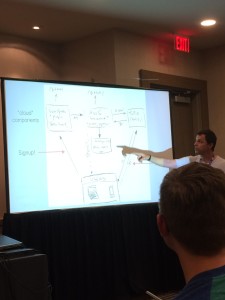Playwrights and directors alike are consistently looking out for new ways to push their medium forward. Avant-garde theatre is well-known for taking risks and telling stories in new ways. This spirit of innovation and the willingness to try new things represents a kinship between the world of theatre and tech industries. Fittingly, there is a contingent of tech developers, playwrights and directors working to steer their respective spheres into convergence. These innovators came together to discuss their efforts at a session during this year’s SXSW Interactive conference.
Two of the assembled speakers come from the world of theater. Kaci Beeler is an improvisational actress at Austin’s Hideout Theatre who has worked on multiple projects with another of the panel’s speakers, Steve Moore, the artistic director of Physical Plant Theater.
Their role is to create plays which are performed as text messages. These plays do not take place at a venue and do not feature any costumes. They take place in an entirely digital realm. The format is quite fascinating. People interested in the plays sign up to receive text messages, which roll in over lengths of time that vary from play to play. The text messages come from multiple numbers representing different characters and the receiver is a character within the play. The receiver, however, is not a character who is able to drive the story.
Beeler and Moore have worked on both original plays and plays that are adapted from other works. One source of material for their adaptions is the young adult book “Summer and Bird” by fellow speaker Katherine Catmull. In addition to providing source material for plays, Catmull has also worked with Beeler and Moore on creating the plays themselves.
Putting the finished result of the playwrights into action is coder Thomas Blom. It is his work that ensures the delivery of the plays to audiences.
Text message plays necessitate a division of labor between the creative and the technical. Each of these spheres a set of unique challenges that must be met before the plays can be performed.
One of the biggest challenges that the writers discussed was paring down the story enough to make it compatible with the short, bare bones format of a text message. Catmull detailed the restrictions and told the session’s attendees that the messages sent to audience members are subject to character restrictions similar to those of a tweet.
The pacing of the plays was another issue faced by the writers and Moore discussed two different approaches they have attempted. The first is a synchronized style where everyone that is participating in the play receives the story at the same time. This is contrasted with an on-demand form of storytelling where the audience can choose the stories pace for themselves, stopping and starting it as their day allows.
As an actress, Beeler has faced a range of challenges given that some text-message plays are performed in an improvisational style. She and her fellow actors have to think quickly or they risk exposing their audiences to the equivalent of on-air silence.

Given the multitude of challenges faced by those in creative roles and the time limitations of the session, solutions to all of these problems were not explored in-depth. It is also true that the medium is emergent and, as a work-in-progress, solutions for every problem have not emerged yet because various approaches are still being put to the test. In regard to the creative aspect of these productions, the session served primarily as a crash course for its audience. It exposed them to a new art form warts and all.
The tech side of the project, however, was discussed with a bit more certainty. Blom reviewed the protocol with the audience, and compared it to classic, early-generation computer games that were primarily text drive. He uses coded algorithms to produce functions that send particular messages or aspects of the story based on an audience member’s responses.
In the end, this session emerged as a fast and furious crash course in an exciting new twist on what a play can be. The idea is so novel that the session was inevitably unable to impart a full understanding of an art form that is still taking shape. It thus left a few questions, but it also did the important work of whetting appetites for inventive collaborations between spheres that are not normally associated with one another.
